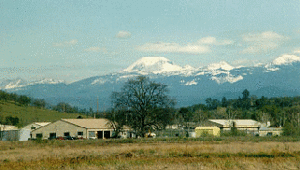Coleman National Fish Hatchery facts for kids
The Coleman National Fish Hatchery is a very important place in Shasta County, California. It's like a special fish farm for salmon and steelhead. This hatchery was built in 1942 to help fish populations. It helps make up for the homes and breeding grounds that fish lost when big dams were built.
The hatchery is located near the town of Anderson. It sits on the north side of Battle Creek, about 6 miles east of the Sacramento River. The Coleman National Fish Hatchery is huge! It covers about 75 acres of land. It's actually the largest salmon hatchery in the entire continental United States.
Contents
What is the Coleman Fish Hatchery?
The Coleman National Fish Hatchery is a special facility that raises young fish. Its main goal is to help keep populations of Chinook Salmon and steelhead strong. These fish are very important to California's environment and its fishing industry.
Why Was the Hatchery Built?
Before the Shasta and Keswick Dams were built, salmon and steelhead could swim far up the Sacramento, Pit, and McCloud Rivers. These rivers were their natural places to lay eggs and raise their young. But when the dams were constructed, they blocked these paths. This meant fish couldn't reach about half of their important breeding areas.
To solve this problem, the Coleman National Fish Hatchery was created in 1942. It was built to help replace the fish that could no longer be born naturally. The hatchery's job is to make sure there are still plenty of salmon and steelhead. This helps both the ocean fishing businesses and people who fish for fun in rivers and the ocean.
How Does the Hatchery Help Fish?
The hatchery plays a big role in the life cycle of salmon and steelhead. Adult fish, returning from the ocean, swim up the Sacramento River and into Battle Creek. They are attracted by the water flowing into the hatchery.
The Amazing Salmon Life Cycle
Once the adult fish are at the hatchery, their eggs are carefully collected. These eggs are then fertilized and kept in special tanks. This is called "artificial incubation." It helps the eggs hatch safely. After the tiny fish hatch, they are called "fry." They grow bigger in large outdoor ponds at the hatchery. When they are strong enough, they are released into the river. From there, they begin their journey to the ocean.
Where Do the Fish Go?
The Coleman National Fish Hatchery aims to raise a lot of fish every year. For example, they plan to raise:
- 12,000,000 fall Chinook salmon
- 1,200,000 late-fall Chinook salmon
- 250,000 winter Chinook salmon
- 600,000 steelhead
Some of the winter Chinook salmon are raised at a smaller hatchery called Livingston Stone National Fish Hatchery. This hatchery is located right at the base of Shasta Dam.
How Does the Hatchery Get Water?
The hatchery needs a lot of fresh water to raise the fish. It gets this water from Battle Creek. There are three special places, called "intakes," that bring water into the hatchery.
The main intake is located where water flows out from the Pacific Gas and Electric (PG&E) Coleman Powerhouse. Water from this intake travels through a large pipe, about 46 inches wide, into a canal. There's also a second intake on the other side of Battle Creek. This second intake acts as a backup. It helps supply water if the main intake needs a break. Both of these intakes are about 1.6 miles upstream from the hatchery.
A third intake is located about 1.2 miles upstream from the hatchery. Water from this intake travels through another large pipe, about 48 inches wide, directly to the hatchery. All the water brought in can either go through a special cleaning process or directly to the fish-rearing areas.


